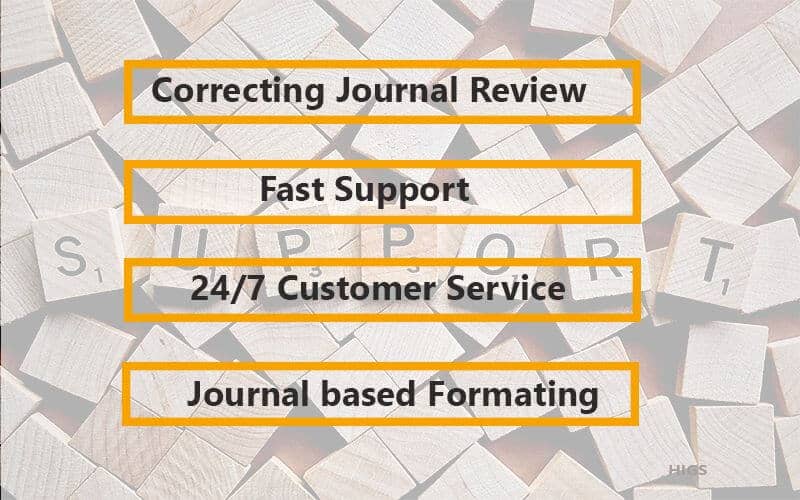Journal comments correction
Our team can help you in how to correct a published article, how to write reviewer comments, and show you journal review example. We, people, are here to give you an excellent service of Journal comments correction services. A paper submitted to the respective Journal is reviewed anonymously by experts in the same field with the aim of determining whether the paper is appropriate for publication or not. Our team responds to reviewer’s comments on submitted articles, and more.
The review method assists our editors to make a decision on what to publish and how to publish, and it assures that the excellence and reliability of the papers and of the journal itself. The reviewer must recognize any fault in the paper and offer useful advice to the authors so that they can progress their work before publication. Other researchers in the field of research offer this service to you when they review papers you have written, and as a great knowledged member of the scientific research community, every researcher should respond by reviewing the research papers in return. Additionally, peer review can offer another reimbursement such as keeping you on current progress in the field of research and awareness of the latest research consequences before they are published.
4 Smart Tips for providing journal comments correction
Peer review is a very critical portion of the publication cycle. It helps to make sure the manuscript and journal quality. The process and its motives are to offer written feedback in the form of commentary to the author, prior to the process of the paper publication. Peer review comprises two sections they are reading and evaluating the research work, followed by communicating your evaluation to the author.
But the main motive is to sustain and support the writing in progress. A well-delivered peer review process advances the scientific quality, and also it shows the novelty of the reported research, and most significantly it also helps to advances the researcher’s career. Here we have notified some of the important peer-review processes by offering clear guidelines and resources. In this, we offer several tips on how to distribute effectual feedback to advance manuscript quality.
Be Kind
The basic principle of the peer review process is to motivate the writing process of the entire paper. The manuscript is an outline that the author looks for supportive advice on the writing, so it requires a fair review. Authorize the writer to progress their research paper writing and develop thoughts and ideas. You must start always with a positive note and then move on to a negative note because commenting in this way may give positive vibes on author’s mind. In order to offer a great note of comments, the reviewer must study and follow the required steps to progress their manuscript.
Provide proper advice
Be detailed with your advice and feedback and we support your remarks and opinions with proof, models, and proposals for the development of the research paper. And the reviewer must be professional in their own way and he/she must be ready to share all the positive and negative feedback about an article. Reviewing and commenting is an important feature of a research work that needs a well-framed investigation and acquisitive knowledge about an article to share the comments. This needs the referees to read the work seriously and they must look for strengths, importance, briefness, and overall consistency in the manuscript draft.
Seek some support and don’t assume the work
As an invited referee, the reviewer must efficiently offer practical criticism in order to progress the work of a peer. Yet, young reviewers who review their first document may learn efficiency via a senior mentor, journal, or online guidelines. But be certain to study the invitation to refer it completely, make sure the due date, and pursue exact commands. Some procedures and guidelines are available for researchers beginning the procedure of peer review to follow through. The procedure can be deconstructed into 2 steps they are reading the manuscript as a reviewer followed by writing a good review.
Be scientific and don’t neglect the details
Reviewers are often specialists in their appropriate domains, though in numerous occurrences they may be invited to evaluate it from a broad perspective. Even if you are not an expert in the particular domain, uphold scientific severity, read seriously, and accurately divide the analysis. Alert the editor of any scientific inaccuracy, advice if the manuscript should be established or redirected elsewhere. Some people believe that the system of peer review is basically defective. Sample peer reviews are accessible on academic websites, whereas others proffer a framework for phrasing. Accurate and scientifically correct the peer reviews offer precise quality control.
- 1. Will you do the revision and resubmission process?
- 2. May I know whether you will accept the papers only written by HIGS or from outside?
- 3. What qualifications do your reviewers and editors team have?
- 4. Will you keep my paper confidential?
- 5. How can I know my revision status?
- You will be provided with a separate username and password. And also you will be notified with the status of your work through emails.
How to respond to the reviewer comments journal example?
- You must speak to all the point augmented by the editor and reviewers.
- Give particulars of the revisions to your manuscript in your answer letter.
- Carry out any additional experiments or study the advice of the reviewer. If not you suffer that they would not make your paper better.
- Give a polite and scientific cancellation to any points or comments you oppose with
- Differentiate between reviewer comments and your responses in your letter
- Clearly demonstrate the main revision in the text, either with a diverse color text, by highlighting the alteration, or with Microsoft Word’s track changes aspect.
- Return the revised manuscript and response letter within the time phase the editor tells you.

Examples
Comments from the reviewer
In your analysis of the data you have preferred to use a somewhat obscure fitting function. In my opinion, a simple Gaussian function would have sufficed. Furthermore, the outcome would be more informative and easier to evaluate earlier results.
Response in accord with the reviewer
We concur with the reviewer’s evaluation of the analysis. Our customized function does create it not likely to fully understand the data by means of the established theories. Additionally, in its existing form, we concur it would be hard to tell that this measurement comprises a significant growth over formerly reported principles.
You must note that in both comments the author is polite and demonstrates respect for the reviewer’s belief. Also, in both conditions, the author modifies the manuscript that addresses the reviewer’s question. While commenting, one must always remember, the reviewer is possibly a highly knowledgeable person. If their suggestion is wrong, it is likely because they misunderstand your document correctly, representing that you should make your text clearer.


